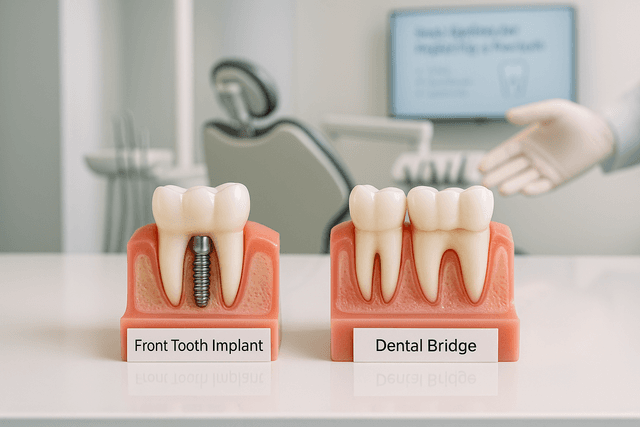Prosthodontics
Price of Tooth Replacement: With and Without Insurance
Missing a tooth can impact more than just your smile, it can affect your ability to eat, speak, and feel confident. Whether you're exploring your options after a recent extraction or planning ahead, understanding the true cost of tooth replacement is essential, especially when insurance is (or isn't) part of the equation.
5 min read
Aug 25, 2025

If you’ve got a gap where a tooth used to be, you’ve probably Googled something like how much do dental implants cost and immediately winced. Totally normal. Dental implants aren’t exactly a small-ticket item, but they can make a huge difference in your health, your confidence, and, let’s be honest, how many selfies you’re willing to post.
Whether you’ve just lost a tooth or you're still nursing a set of damaged teeth that need to go, this guide will walk you through what affects the cost of dental implants, how dental insurance plays into it, and what your real options look like.
Let’s break down the dollars and details.
Dental Implant Pricing Basics
Dental implant costs can vary wildly, but here’s a general idea to start with: the implant cost for a single dental implant can range from $3,000 to $6,000. And that’s just for one tooth. Got multiple implants needed? Well, we’ll get to that financial roller coaster in a minute.
The average cost of dental implants includes:
The dental implant procedure itself (implant placement)
The dental crown that goes on top of the implant
Any additional costs like X-rays, consultations, and bone grafts
If you're thinking, "that sounds like a lot," you're not wrong. But it's also a long-term fix. Dental implants can last a lifetime, which makes them a strong alternative to temporary fixes like dentures or dental bridges.
How Much Do Dental Implants Cost Without Insurance?
Here’s the part most people dread. If you don’t have dental insurance, the cost of a single implant typically falls somewhere between $3,000 and $5,000 depending on the type of dental procedure, your dental office, and your location. Higher cost of living areas like New York or San Francisco? Expect prices to be on the upper end.
The total cost for a single tooth implant may also rise based on additional costs like:
Sedation or anesthesia
3D imaging and dental implant consultation
Gum or bone prep (not everyone needs it, but it’s common)
Let’s say you need a single tooth dental implant and also require a bone graft. That could bring the total cost up by $500 to $1,000 more. Yes, the cost can be daunting, but hang tight, we’ll talk about financing options and insurance help too.
What Dental Implant Costs Look Like With Insurance
So what if you’ve got dental insurance? First, take a breath, it’s not going to cover the entire bill, but it can help.
Most dental insurance providers treat implants as a “major procedure,” which means they’ll usually cover a percentage (often 50%) after your deductible. Keep in mind: there might be waiting periods, yearly maximums, and restrictions depending on your plan.
A few good things to check with your provider:
Does your plan cover tooth implant procedures?
What is the annual maximum benefit?
Are there any dental implant options they exclude?
And here’s a fun surprise (not really): some dental insurance plans don’t cover implants at all. Why? They still consider them cosmetic, even though implants are usually more than just aesthetic, they function like natural teeth and help prevent further dental problems like bone loss or shifting natural teeth.
Factors That Affect the Cost of Dental Implants
Here's what else can affect the cost of dental implants:
Type of implant used (some are more expensive but last longer)
Experience level of your dentist
Your overall dental needs (bone grafts, sinus lifts, etc.)
Materials used in the crown or post
Number of replacement teeth
Some patients may even need zygomatic implants, which are longer and more complex (read: pricier). Others might require multiple implants to restore several missing or damaged teeth.
Then there’s geography. Where you get your dental treatment matters. A dental clinic in a major city? Usually pricier. But a dental school like the Pennsylvania School of Dental Medicine can help you save significantly while still getting quality dental care under supervision.
Dental Implant Procedure Step-by-Step
For those curious, here’s how it works:
Tooth extraction (if needed)
Bone grafting (maybe)
Healing period (3–6 months)
Done!
The whole implant treatment can take a few months, but the result? A tooth that feels just like the one you lost.
Dental Implants Are an Investment
Sure, a tooth implant isn’t cheap. But here’s the thing: dental implants are an investment in your oral health, your comfort, and your quality of life. Unlike dentures that can slip or wear out, dental implants can last a lifetime with proper care.
Plus, they help preserve bone and stop that “sunken face” look that can happen when you're missing teeth. That’s worth a few extra bucks, right?
Make Dental Implants More Accessible
Not ready to fork over thousands of dollars upfront? Most people aren’t. Thankfully, there are ways to make dental implants more accessible:
Patient financing options like CareCredit or in-house payment plans
FSAs and HSAs (those pre-tax health savings accounts)
Asking your dental care team about discounts for cash payments or bundled treatments
Also, many dental offices work with third-party financing companies to help you pay for dental implants over time.
Implant Treatment for Missing Teeth
Dental implants are often the best choice for long-term results, and while the upfront cost may sting a little, the payoff is real. With smart planning, patient financing options, and the right dental care team, you can make dental implants work for your smile and your budget.
If you’ve got one single implant, it’s the gold standard. It won’t mess with nearby natural teeth, and it helps keep your bite strong and aligned.
Got several teeth gone? You might not need one implant per tooth. Strategic implant placement can support bridges or even full arches. Your dental care provider will walk you through the right type of dental implant for your case.
How Much Do Dental Implants Cost Without Insurance?
Without insurance, the cost of a single dental implant typically ranges from $3,000 to $6,000. This includes the implant itself, the abutment, and the crown. Additional procedures such as bone grafts, extractions, or 3D imaging can increase the total cost by several hundred to over a thousand dollars. Prices also vary based on your location, with higher costs in urban areas or regions with a higher cost of living.
Does Dental Insurance Cover the Cost of Implants?
Most dental insurance plans classify implants as a major procedure and may cover about 50% of the cost after the deductible. However, coverage often depends on annual maximum benefits and exclusions within your plan. Some policies exclude implants entirely, considering them cosmetic, while others may cover related procedures like crowns or extractions. It’s important to verify coverage details with your provider before starting treatment.
What Factors Can Increase the Price of a Dental Implant?
The final cost of implants depends on several factors, including the type of implant used, the dentist’s expertise, and the materials chosen for the crown. Additional treatments like sinus lifts, bone grafts, or sedation also raise the overall price. The number of missing teeth also matters, while a single implant is costly, multiple implants may be placed strategically to support bridges or full arches, impacting the total expense.
Are There Affordable Options to Help Pay for Dental Implants?
Yes, there are several ways to make dental implants more affordable. Many dental offices offer financing plans or work with third-party providers like CareCredit to spread costs over time. Patients with flexible spending accounts (FSAs) or health savings accounts (HSAs) can also use pre-tax funds toward implants. In some cases, dental schools provide implant procedures at reduced rates, offering a cost-effective alternative while maintaining quality care under supervision.
Read Next
Related Posts

Prosthodontics
Low Cost of Dental Implants: How to Balance Price and Quality
If the cost of dental implants has ever made you hesitate, you're not alone. While they’re considered the gold standard for replacing missing teeth, navigating their price tag without sacrificing quality can be overwhelming. This guide breaks down everything you need to know about balancing affordability with long-term value.
6 min read
Aug 25, 2025

Prosthodontics
Front Tooth Implant vs. Bridge: The Best Choice for Your Smile
Losing a front tooth can be more than just a cosmetic concern, it can affect your speech, confidence, and daily comfort. Fortunately, modern dentistry offers reliable solutions like dental implants and bridges to restore both function and appearance. Choosing between them starts with understanding how each option works and what makes them unique.
7 min read
Aug 25, 2025

Prosthodontics
Who Does a Dental Implant? Understanding the Specialists Involved
Getting a dental implant isn’t just about replacing a missing tooth, it’s about restoring function, health, and confidence. But many people don’t realize that the procedure often involves more than one type of dental professional. Different specialists bring unique expertise to ensure the implant looks natural, feels secure, and lasts for years.
6 min read
Aug 25, 2025
Don’t have time to research every dentist around you?
See why 30k+ patients trusted us